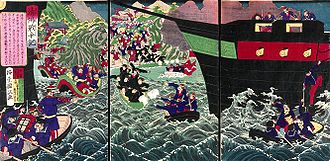
Utagawa Kunisada III
Encyclopedia

Ukiyo-e
' is a genre of Japanese woodblock prints and paintings produced between the 17th and the 20th centuries, featuring motifs of landscapes, tales from history, the theatre, and pleasure quarters...
printmaker of the Utagawa school
Utagawa school
The was a group of Japanese woodblock print artists, founded by Toyoharu. His pupil, Toyokuni I, took over after Toyoharu's death and raised the group to become the most famous and powerful woodblock print school for the remainder of the 19th century....
, specializing in yakusha-e
Yakusha-e
Yakusha-e , often referred to as "actor prints" in English, are Japanese woodblock prints or, rarely, paintings, of kabuki actors, particularly those done in the ukiyo-e style popular through the Edo period and into the beginnings of the 20th century...
(pictures of kabuki
Kabuki
is classical Japanese dance-drama. Kabuki theatre is known for the stylization of its drama and for the elaborate make-up worn by some of its performers.The individual kanji characters, from left to right, mean sing , dance , and skill...
actors). He began studying under Utagawa Kunisada I
Kunisada
Utagawa Kunisada was the most popular, prolific and financially successful designer of ukiyo-e woodblock prints in 19th-century Japan...
at the age of 10, and continued under Kunisada II
Utagawa Kunisada II
Utagawa Kunisada II was a Japanese ukiyo-e printmaker, one of three to take the name "Utagawa Kunisada."A pupil of Utagawa Kunisada I, he signed much of his early work "Baidō Kunimasa III." He took the name Kunisada after marrying his master's eldest daughter in 1846. He changed his name once more...
after their master's death.
He originally signed his prints "Kunimasa" or "Baidō Kunimasa". About 1889, he began signing his prints "Kunisada", "Baidō Kunisada" or "Kōchōrō Kunisada". By 1892, he was using "Hōsai", "Kōchōrō Hōsai", "Baidō Hōsai", and "Utagawa Hōsai".

